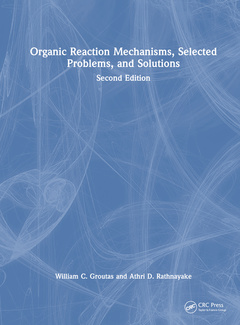Organic Reaction Mechanisms, Selected Problems, and Solutions Second Edition
Auteurs : Groutas William C., Rathnayake Athri D.

This fully updated new edition presents organic reaction mechanism questions, carefully selected from the primary chemical literature, to understand how reactants are transformed into products. The author explains step-by-step solutions to all problems with appropriate contextual comments explaining the rationale and reasoning underlying each step, and identifying the underlying principles involved in each question. In the process the reader gains a better understanding of the fundamental principles of organic chemistry and how to become proficient in using the Lewis acid/Lewis base concept to complete organic reactions without resorting to memorization.
Features :
- The questions are graded in difficulty with Part A containing questions aimed at students taking the sophomore-level organic chemistry class, while part B contains questions of somewhat greater difficulty suitable for students taking an honors course in organic chemistry or a beginning graduate course.
- Detailed answers are provided to all questions so students can check their answers and important points are highlighted in each answer. Special emphasis has been placed on the selection of questions to ensure that each question illustrates one or more fundamental principles of organic chemistry.
- Interspersed throughout the book are minireviews that cover the material pertaining to a particular topic.
- The specific literature references corresponding to each question are included and students can look up those references for more contextual information.
- Includes a large number of carefully-selected mechanism questions and step-by-step solutions, including explanatory comments
Glossary
A note on writing mechanisms
Part A
Minireview1 Lewis structures
Minireview 2 Lewis acids and bases, and Lewis acid/Lewis base reactions
Minireview 3 Resonance
Minireview 4 Carbocation Chemistry
Questions 1-34
Answers to questions 1-34
Minireview 5 Formation of Anions (Nucleophiles)
Minireview 6 Nucleophilic Substitution Reactions (SN2) and Elimination Reactions (E2)
Minireview 7 Chemical Reactivity and Ring Strain
Questions 35-50
Answers to questions 35-50
Minireview 8 Nucleophilic Addition Reactions of Aldehydes and Ketones
Questions 51-70
Answers to questions 51-70
Minireview 9 Nucleophilic Acyl Substitution Reactions
Questions 71-200
Answers to questions 71-200
Part B
Questions 201-490
Answers to questions 201-490
Part C
Questions 491-500
Answers to questions 491-500
Professor William Groutas - expertise and research interests lie in the general areas of organic medicinal chemistry, structure-based drug design, mechanistic enzymology, drug discovery and development, and combinatorial chemistry. The study of human and viral proteases, and the role they play in health and disease, has been the unifying theme of our research program. My extensive experience in antiviral drug discovery and development has been primarily focused on the structure-based design of inhibitors of an array of viral proteases, including norovirus, picornavirus, SARS-CoV-2, SARS-CoV and MERS-CoV proteases. An integral component of our studies has been the application of an array of tools and methodologies, including structure-guided drug design, computational chemistry, X-ray crystallography and high-field NMR, to probe the mechanism of ligand-receptor interactions and to address fundamental questions related to the design of novel broad-spectrum antivirals that also display enhanced resistance profiles. Ongoing research projects in my lab are translational in nature and driven by a basic science component. A noteworthy highlight of our investigations has been the recent discovery of a small molecule therapeutic (GC376) that is currently in clinical development for the treatment of feline infectious peritonitis (FIP) and COVID-19.
Dr. Athri D. Rathnayake - is a medicinal chemist with drug discovery research emphasis on viral infectious diseases, neurodegenerative diseases, oncology, and inflammatory diseases. He did his postdoctoral studies in the Department of Chemistry at Northwestern University and is currently affiliated with Biotheryx Inc.
Date de parution : 05-2023
21x28 cm
Date de parution : 05-2023
21x28 cm
Thèmes d’Organic Reaction Mechanisms, Selected Problems, and... :
Mots-clés :
Lewis acids and bases; Lewis acid; Lewis base reactions; Carbocation chemistry; Nucleophilic substitution reactions; Chemical reactivity and ring strain; Organic medicinal chemistry; Aldehydes and ketones; Organic Reaction Mechanisms; Lewis Bases; Lewis Acids; Lewis Structures; Ring Strain; Carboxylic Acid Derivatives; Nucleophilic Acyl Substitution; Alkyl Halide; Non-bonded Electrons; Strong Lewis Base; Electronegative Atom; Michael Addition Reactions; Ambident Nucleophiles; Nucleophilic Addition Reactions; Electrophilic Aromatic Substitution Reactions; COR; DIEA; Acid Halides; Partial Positive Charge; Pi Electrons; Nucleophilic Addition; Elimination Reaction; HO; Conjugate Bases



